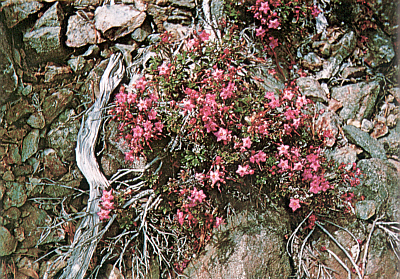QBARS - v26n3 Kalmiopsis leachiana
Kalmiopsis leachiana
J. W. Gerdemann, Urbana, Illinois

|
|
FIG. 75.
Kalmiopsis leachiana
growing in typical rocky habitat.
J. W. Gerdemann photo |
Kalmiopsis leachiana , an attractive dwarf evergreen shrub with bright rose pink flowers, was discovered in the Siskiyou Mountains in Southwestern Oregon in 1930 by Mr. and Mrs. J. R. Leach of Portland. It was first described as Rhododendron leachianum (2) and placed in the Lapponicum series. One year later Rehder (3) transferred the species to a new monotypic genus Kalmiopsis . He indicated a close relationship of the new genus to Loiseleuria, Kalmia , and Rhododendron , and he noted that in some respects it also resembled Phyllodoce and Rhodothamnus . He suggested that Kalmiopsis, Loiseleuria , and Rhodothamnus were phylogenetically old types of the Tertiary and that Rhododendron, Kalmia , and Phyllodoce were probably derived from them.
Copeland (1) transferred K. leachiana to the genus Rhodothamnus , but this change has not been accepted. He reported that the scale-like glands on the underside of the leaves of Kalmiopsis were essentially different from those of Rhododendron , and gave this as the main reason for transferring K. leachiana to Rhodothamnus which lacks glands of any type on its leaves! As Rehder pointed out in his excellent paper, Kalmiopsis differes from Rhodothamnus in a number of characteristics.
Kalmiopsis leachiana is an extremely rare plant, generally found in the most inaccessible places. Our favorite place to see it is in the 76,200 acre Kalmiopsis Wilderness Area in the Siskiyou National Forest in Southwestern Oregon. This region has been described as a botanists' paradise because of the many rare endemic species that grow here. The beautiful and extremely rare Brewer's weeping spruce is found in this area. If you would like to see Kalmiopsis in its native habitat, it would be wise to get careful directions. One could hike for days through this rugged country without ever seeing it. When one finds a colony of Kalmiopsis , it may be locally very abundant. A slope covered with Kalmiopsis in full bloom is a never - to be-forgotten sight. Some very large colonies can be found near Dry Butte. In this area plants with lovely clear light pink flowers are found along with the more common rose pink form. One of the easiest colonies to visit is on the Illinois River trail near York Creek. From the end of the Illinois River road one can make a round trip over an easy and very scenic trail in several hours. However, please remember that collecting is prohibited. A small colony such as this could easily be destroyed.
Recently several small colonies of Kalmiopsis have been found in the Cascades near the North Umpqua River. These colonies are all fairly accessible but careful directions are necessary in order to find them. Plants from this region are referred to as the LePineac or Umpqua form.
Kalmiopsis always occurs in extremely arid rocky habitats. In the Siskiyous it is found growing in loose rock containing very little soil or in cracks in rock outcroppings. At Indian Cave on the North Umpqua it grows in soil only a few inches deep on top of rock pinnacles. It often grows in full sun but is at its best in locations that are in light shade for a part of the day.
The Siskiyou form has proved to be very difficult to cultivate and few collectors are able to keep it alive for very long. No doubt it requires perfect drainage. The Umpqua form is much easier to grow; however, it too requires good drainage, and it also may die for no apparent reason. I suspect that it is very susceptible to attack by common soil-borne pathogens. It has been cultivated with considerable success in pure organic matter such as peat or bark chips. I estimate its hardiness to be at least -10°. It is reasonably hardy at Urbana, Illinois but it can be severely damaged by bright late winter sunshine, particularly if the soil is frozen.
Kalmiopsis is a lovely rock garden plant and a good companion plant for dwarf Rhododendrons. The foliage is aromatic. The leaves are dark green and glossy and the scales on the undersurface appear as tiny flecks of gold. Well grown plants nearly cover themselves with showy flowers. No doubt the difficulty in cultivating it has greatly restricted its use as an ornamental. A better understanding of its requirements should greatly increase its popularity.
REFERENCES
- Copeland, H. F. 1943. A study, anatomical and taxonomic. of the genera of Rhododendroideae. Amer. Midland Naturalist 30:533-625.
- Henderson, L. H. 1931. New plants from Oregon. Rhodora 35:203-206.
- Rehder, A. 1932. Kalmiopsis, a new genus of Ericaceae from Northwest America. lour. Arnold Arboretum 13:30-34.
